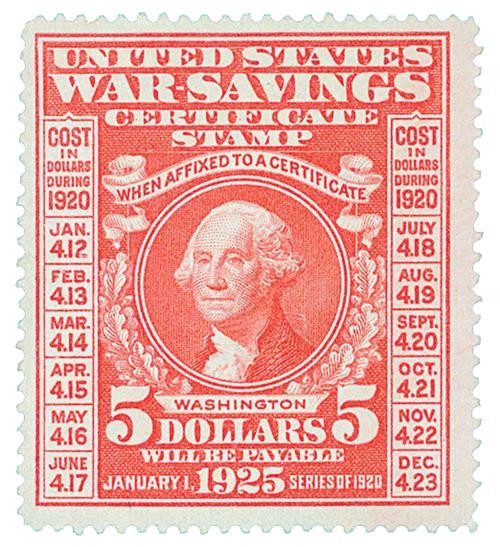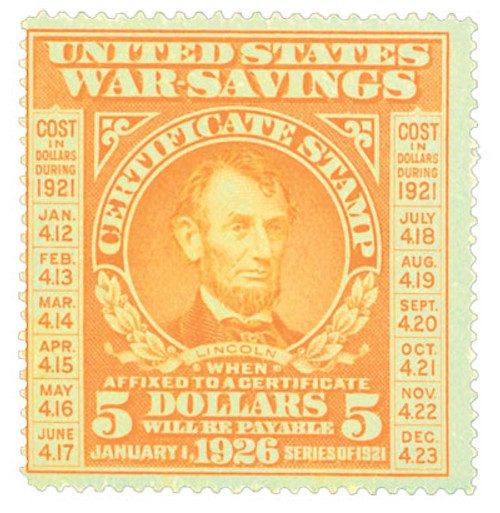On December 1, 1917, first War Savings Stamp, WS1, was issued.
When America entered World War I in April 1917, there was an immediate push to support the war effort. Weapons were needed, as well as clothing, food, and supplies for the men fighting overseas. In the coming months, the U.S. government instituted a number of programs to encourage the public to donate what they could, including war bonds and liberty bonds.

Among these efforts to raise funds was War Savings Stamps. The first War Savings thrift stamp (WS1) was issued on December 1, 1917. The second stamp, WS2, was issued a few weeks prior, but wasn’t meant for use until 1918.
Issued by the Treasury Department, War Savings Stamps were sold in many convenient places. Not only were these stamps sold at banks and post offices, but they were available at the train station or they could be purchased from the milkman on his delivery route. In 1918, these stamps were available in 45,000 different places in Texas alone.

Citizens were encouraged to think of inventive ways to use the thrift stamps. Businesses gave them as bonuses and Christmas presents. They were handed out as tips in restaurants and hotels. At a café in Dallas, Texas, the menu offered “pie and thrift stamp” for 30¢.
The stamps issued during World War I were available in 25¢ and $5 denominations. The $5 War Savings stamp cost $4.12 when issued and earned 4% interest, or a penny a month. When they matured five years later, they could be redeemed for $5.
Children were encouraged to purchase the 25¢ stamps and provided with a special card to paste 20 stamps. Completed cards could be exchanged for a $5 War Savings stamp by paying the difference between their $4 value and the current price of the $5 stamp.
The Treasury Department used clever ads to encourage people to buy the stamps. One claimed, “An idle Quarter is a slacker Quarter.” Many posters also used patriotism to spur purchases. President Woodrow Wilson supported the drive, calling upon “every man, woman, and child” to save for the war. He also proclaimed June 28, 1918, to be National War Savings Day. Click here to see a selection of WWI War Savings posters.
The Boy Scouts of America alone sold $53 million in War Savings stamps during World War I – that’s over two million stamps. Boy and Girl Scouts sold so many stamps that there was a slogan – “Every Scout to Save a Soldier.”
The program was successful in raising money for the war effort. By September of 1919, over $1.1 billion worth of stamps had been sold. The low 25¢ cost allowed almost anyone to “Help Lick the Kaiser.”
The first round of War Savings stamps were issued through 1920. The program was begun again in 1942 after America joined World War II. Denominations of 10¢, 50¢, and $1 were added. The War Savings stamps of World War II earned no interest and were redeemable in the form of U.S. Treasury War Certificates, Defense Bonds, or War Bonds.
Promotion of War Savings stamps during World War II was closely linked to the promotion of Series E War Bonds, which they were usually used to purchase. Advertisers donated $250 million worth of advertising in the form of trolley car posters, songs, and movies starring Frank Sinatra and Bob Hope.
The design of the World War II stamps featured the famous “Minuteman Statue” in Concord, Massachusetts. It was made to commemorate the Battle of Lexington and Concord – the first conflict of the American Revolution. The statue shows a farmer standing next to his plow, holding a musket. It represents the willingness of the common man to serve the cause of freedom – just like those who fought at Concord and Lexington.
Click here to see what else happened on This Day in History.





The story of a lost “spirit.”
Like Savings Bonds, War Stamps had the principal purpose of taking some liquidity out of the economy. By increasing the savings rate, these devices were helpful in holding down wartime inflation — to what degree I do not know.
When were these discontinued? I remember purchasing “savings bond stamps” at the school supply store in 1957.
Savings Bond Stamps were sold up to about 1970. You’d collect them in a booklet and when the booklet was full could trade it for a savings bond. Was a way school kids or their parents could purchase these bond stamps over time – some were 25 cents each – and ultimately get a savings bond.
Maybe you lost your “spirit” Paul, but, the majority of Americans are happy and willing to do “their part”. We haven’t lost anything except for trusting our politicians. What were you doing when we “lost it”. hitting some furry ball over some net? Stamps have all ways been a part of our history. Try selling saving stamps for the war in Afganistan. Collect on !
I still have a book of stamps, bought weekly in grade school
In philately, CINDERELLA STAMPS mean anything resembling a postage stamp, but NOT used for postal purposes by postal administration. Examples are 1. Thrift stamps 2.Stamps issued by governments in exile such as ten stamps issued by Indian National Army of Netaji Subhash Chandra Bose. 3. Non official railway stamps issued by U.K. and Australia 4.Gift stamps (total 41 stamps) issued by UNESCO. It is interesting to note that on June 5, 1959, Cinderella Stamp Club was founded in London , England. The Club publishes quarterly journal The Cinderella Philatelist . The Club, it is claimed, is an Associate Member of American Philatelic Society.
Thank you, Mr Sudhir Tare for the information concerning ‘Cinderella Stamps’. Also, all stamps issued by the South Moluccas Islands, of which I have. They carry no postal value, but a nice conversation piece as a stamp dealer ones mentioned.
Great information everyone thanks, I’m new with stamps and love all the info I can get! I need to find somewhere to buy in person maybe a show or something around the mid-Atlantic region. So cool!!